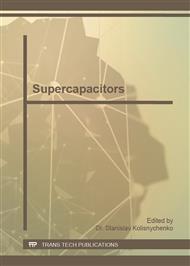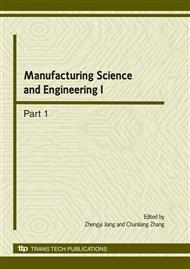p.1562
p.1569
p.1573
p.1578
p.1582
p.1586
p.1590
p.1595
p.1601
Study on Activated Carbon /Polyaniline Electrode Materials for Supercapacitorsts
Abstract:
Activated carbon (AC)/polyaniline (PANI) composite electrode materials were synthesized in this article. The effect of preparation such as BET surface area and porous size of AC on the electrochemical performances of AC/PANI composite material was investigated. The electrochemical performances of the composite were tested with cyclic voltammetry, galvanostatic charge-discharge and electrochemical impedance spectrometry in 6mol/L KOH solution using Hg/HgO as reference electrode. Composite surface morphology was examined by scanning electron microscope (SEM). The result shows that when the ratio of AC to aniline increases, the conversion of aniline and the capacitance value of composite also increase in keeping the ratio of AC to aniline constant. When AC: aniline : (NH4)2S2O8 =7:1:1, the conversion of aniline up to more than 95% and the capacitance value of electrode materials increased from 239F/g(pure AC) to 409F/g, which is 71.1% higher than pure AC. Pore structure of AC also has great effect on electrochemical performances of electrode material. With the increase of proportion of mesoporous, the electrochemical properties of composite are greatly increased.
Info:
Periodical:
Pages:
1582-1585
Citation:
Online since:
March 2010
Authors:
Price:
Сopyright:
© 2010 Trans Tech Publications Ltd. All Rights Reserved
Share:
Citation:



